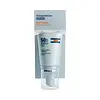What's inside
What's inside
 Key Ingredients
Key Ingredients

 Benefits
Benefits

 Concerns
Concerns

 Ingredients Side-by-side
Ingredients Side-by-side

Water
Skin ConditioningAlcohol Denat.
AntimicrobialOctocrylene
UV AbsorberC12-15 Alkyl Benzoate
AntimicrobialButyl Methoxydibenzoylmethane
UV AbsorberDibutyl Adipate
EmollientTalc
AbrasiveBis-Ethylhexyloxyphenol Methoxyphenyl Triazine
Skin ConditioningCyclopentasiloxane
EmollientTromethamine
BufferingCyclohexasiloxane
EmollientAmmonium Acryloyldimethyltaurate/Vp Copolymer
Cellulose
AbsorbentMethylene Bis-Benzotriazolyl Tetramethylbutylphenol
UV FilterPhenylbenzimidazole Sulfonic Acid
UV AbsorberPolymethylsilsesquioxane
Polyacrylamide
PEG-40 Hydrogenated Castor Oil
EmulsifyingC13-14 Isoparaffin
EmollientCarbomer
Emulsion StabilisingPanthenol
Skin ConditioningTocopheryl Acetate
AntioxidantParfum
MaskingDecyl Glucoside
CleansingXanthan Gum
EmulsifyingAcrylates/C10-30 Alkyl Acrylate Crosspolymer
Emulsion StabilisingDisodium EDTA
Laureth-7
EmulsifyingBHT
AntioxidantSodium Lauroyl Glutamate
Linalool
PerfumingLysine
Skin ConditioningPropylene Glycol
HumectantMagnesium Chloride
Water, Alcohol Denat., Octocrylene, C12-15 Alkyl Benzoate, Butyl Methoxydibenzoylmethane, Dibutyl Adipate, Talc, Bis-Ethylhexyloxyphenol Methoxyphenyl Triazine, Cyclopentasiloxane, Tromethamine, Cyclohexasiloxane, Ammonium Acryloyldimethyltaurate/Vp Copolymer, Cellulose, Methylene Bis-Benzotriazolyl Tetramethylbutylphenol, Phenylbenzimidazole Sulfonic Acid, Polymethylsilsesquioxane, Polyacrylamide, PEG-40 Hydrogenated Castor Oil, C13-14 Isoparaffin, Carbomer, Panthenol, Tocopheryl Acetate, Parfum, Decyl Glucoside, Xanthan Gum, Acrylates/C10-30 Alkyl Acrylate Crosspolymer, Disodium EDTA, Laureth-7, BHT, Sodium Lauroyl Glutamate, Linalool, Lysine, Propylene Glycol, Magnesium Chloride
Water
Skin ConditioningGlycerin
HumectantCyclopentasiloxane
EmollientCetearyl Alcohol
EmollientPanthenol
Skin ConditioningUrea
BufferingParaffinum Liquidum
EmollientPetrolatum
EmollientLactic Acid
BufferingAmmonium Acryloyldimethyltaurate/Vp Copolymer
Phenoxyethanol
PreservativeDimethicone Crosspolymer
Emulsion StabilisingOctyldodecanol
EmollientSodium Cetearyl Sulfate
CleansingSodium Hydroxide
BufferingEthylhexylglycerin
Skin ConditioningParfum
MaskingLimonene
PerfumingHexyl Cinnamal
PerfumingUbiquinone
AntioxidantCoumarin
PerfumingCitral
PerfumingLinalool
PerfumingAlpha-Isomethyl Ionone
PerfumingWater, Glycerin, Cyclopentasiloxane, Cetearyl Alcohol, Panthenol, Urea, Paraffinum Liquidum, Petrolatum, Lactic Acid, Ammonium Acryloyldimethyltaurate/Vp Copolymer, Phenoxyethanol, Dimethicone Crosspolymer, Octyldodecanol, Sodium Cetearyl Sulfate, Sodium Hydroxide, Ethylhexylglycerin, Parfum, Limonene, Hexyl Cinnamal, Ubiquinone, Coumarin, Citral, Linalool, Alpha-Isomethyl Ionone
 Reviews
Reviews

Ingredients Explained
These ingredients are found in both products.
Ingredients higher up in an ingredient list are typically present in a larger amount.
Ammonium Acryloyldimethyltaurate/Vp Copolymer (let's call it AAVC for short) is a synthetically created polymer. It's used as a film-forming agent and used to thicken the consistency of products.
AAVC is able to increase the consistency and viscosity of products due to its large molecule size. It also prevents ingredients from separating.
Cyclopentasiloxane, or D5, is a silicone used to improve texture of products and trap moisture.
D5 is considered lightweight and volatile. Volatile means it evaporates quickly after application. Once evaporated, D5 leaves a thin barrier that helps keep skin hydrated.
It is also an emollient. Emollients help soften the skin and prevent water loss. Silicones create a silky texture in products. D5 helps other ingredients become more spreadable.
Studies show D5 is safe to use in skincare products. We recommend speaking with a skincare professional if you have concerns.
Learn more about CyclopentasiloxaneLinalool is a fragrance and helps add scent to products. It's derived from common plants such as cinnamon, mint, citrus, and lavender.
Like Limonene, this ingredient oxidizes when exposed to air. Oxidized linalool can cause allergies and skin sensitivity.
This ingredient has a scent that is floral, spicy tropical, and citrus-like.
Learn more about LinaloolPanthenol is a common ingredient that helps hydrate and soothe the skin. It is found naturally in our skin and hair.
There are two forms of panthenol: D and L.
D-panthenol is also known as dexpanthenol. Most cosmetics use dexpanthenol or a mixture of D and L-panthenol.
Panthenol is famous due to its ability to go deeper into the skin's layers. Using this ingredient has numerous pros (and no cons):
Like hyaluronic acid, panthenol is a humectant. Humectants are able to bind and hold large amounts of water to keep skin hydrated.
This ingredient works well for wound healing. It works by increasing tissue in the wound and helps close open wounds.
Once oxidized, panthenol converts to pantothenic acid. Panthothenic acid is found in all living cells.
This ingredient is also referred to as pro-vitamin B5.
Learn more about PanthenolParfum is a catch-all term for an ingredient or more that is used to give a scent to products.
Also called "fragrance", this ingredient can be a blend of hundreds of chemicals or plant oils. This means every product with "fragrance" or "parfum" in the ingredients list is a different mixture.
For instance, Habanolide is a proprietary trade name for a specific aroma chemical. When used as a fragrance ingredient in cosmetics, most aroma chemicals fall under the broad labeling category of “FRAGRANCE” or “PARFUM” according to EU and US regulations.
The term 'parfum' or 'fragrance' is not regulated in many countries. In many cases, it is up to the brand to define this term.
For instance, many brands choose to label themselves as "fragrance-free" because they are not using synthetic fragrances. However, their products may still contain ingredients such as essential oils that are considered a fragrance by INCI standards.
One example is Calendula flower extract. Calendula is an essential oil that still imparts a scent or 'fragrance'.
Depending on the blend, the ingredients in the mixture can cause allergies and sensitivities on the skin. Some ingredients that are known EU allergens include linalool and citronellol.
Parfum can also be used to mask or cover an unpleasant scent.
The bottom line is: not all fragrances/parfum/ingredients are created equally. If you are worried about fragrances, we recommend taking a closer look at an ingredient. And of course, we always recommend speaking with a professional.
Learn more about ParfumWater. It's the most common cosmetic ingredient of all. You'll usually see it at the top of ingredient lists, meaning that it makes up the largest part of the product.
So why is it so popular? Water most often acts as a solvent - this means that it helps dissolve other ingredients into the formulation.
You'll also recognize water as that liquid we all need to stay alive. If you see this, drink a glass of water. Stay hydrated!
Learn more about Water